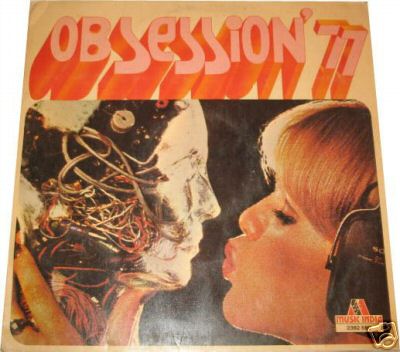
Playlist: Far Out Vibes
Vol. 1 (Day Trips)
01. “La Ragazza Con La Pistola” (Peppino De Luca)
Peppino De Luca was born on January 5, 1936 in Rome. In the 1950s, he played in the Roman New Orleans Jazz Band. In the 1960s, he turned his skills to Italian motion pictures and television. This is the title track from the Academy Award nominated (Best Foreign Language Film) 1968 Mario Monicelli movie of the same name starring Monica Vitti in the main role. An aggressive guitar hammers on as a sitar plucks away and a man screams and shouts “Girl with a Gun!” in the background.
02. “Sitar Beat” (Klaus Doldinger)
Klaus Doldinger was born on May 12, 1936 in Berlin. In the 1950s-1960s, he played in the jazz groups The Feetwarmers and Oscar’s Trio. In the 1970s, he played saxophone, flute, and keyboards in the jazz fusion band Passport. He also began recording music for German movies and television in the 1970s-1980s (he created the soundtrack for the cult fantasy film The Neverending Story in 1984.) “Sitar Beat”, as the name suggests, is a chunky bass and drums extravaganza with sitar in the spotlight.
03. “Hogin’ Machine” (Les Baxter)
Les
Baxter was born on March 14, 1922 in Texas. In the 1940s, he played
saxophone in swing bands. In the 1950s-1960s, he began composing
music that later became known as exotica,
because of its ability to transport everyday, middle-class, suburban
American citizens from the comfort of their living rooms to exotic,
faraway, and sensual terrains. Some of these records include Ritual
of the Savage
(1951), Caribbean
Moonlight
(1956), Midnight
on the Cliffs
(1957), Ports
of Pleasure
(1957), Space
Escapade
(1958), Jewels
of the Sea
(1961), The
Primitive and the Passionate
(1962). Also in the 1960s, Les Baxter composed soundtracks for Roger
Corman’s Edgar Allan Poe adaptations starring Vincent Price (House
of Usher
in 1960 and Pit
and the Pendulum
in 1961) and American versions of Mario Bava’s Black
Sunday
(1960), Black
Sabbath (1963),
Blood
and Black Lace (1964).
In the 1970s, Les Baxter created the soundtracks for The
Dunwich Horror (1970)
and the exploitation films Savage
Sisters (1974)
and Switchblade
Sisters (1975).
In 1969, he recorded his most Americanized soundtrack for
Maury Dexter’s biker flick Hell’s
Belles.
Big bass beats, big brass section, and big drum breaks are
accompanied by fuzzy guitar and harmonica.
04. “Stream” (Piero Umiliani)
Piero Umiliani was born on July 17, 1926 in Florence. He composed soundtracks for the giallo genre (Umberto Lenzi’s 1969 Orgasmo and Mario Bava’s 1970 Five Dolls for an August Moon), as well as the lesbian horror movie Baba Yaga (1973). His standout soundtrack is the 1968 Svezia: Inferno e Paradiso (Sweden: Heaven and Hell) which contains a dizzying, kaleidoscopic score. He specialized in sexploitation during the 1970s. “Stream” is from Luigi Scattini’s The Body (1974), starring Eritrean actress Zeudi Araya in an erotic tale that takes place in Trinidad. “Stream” is powered by its rhythm section–hypnotic bass pulse and tribal percussion.
05. “Rito A Los Angeles” (Peppino De Luca)
Another soundtrack by Peppino De Luca, “Rito a Los Angeles” (from Massimo Dallamano’s 1970 sexploitaiton Sins of Dorian Gray), this is a case of deja vu: the introduction sounds like the opening of Santana’s “Soul Sacrifice” and the guitar directly imitates Iron Butterfly’s “In-a-Gadda-da-Vida”. Despite these similarities, it’s action-packed fun.
06. “Un Soir Chez Norris” (Pierre Cavalli)
Pierre Cavalli was born on July 12, 1928 in Zurich. In the 1950s, he played jazz guitar in Paris and then in the 1960s-1970s he created soundtracks for French movies and television. “Un Soir Chez Norris” is from a 1971 TV show. A choral female vocal soars and swoops as an insistent rhythm section and wah-wah guitar create a car chase urgency.
07. “LSD (Red Hot)” (Piero Piccioni)
Piero Piccioni was born on December 6, 1921 in Turin. In the 1940s/1950s, he played jazz and during the 1960s-1970s, he began composing soundtracks for Italian films and television (Francesco Rosi’s films, Paolo Spinola’s La Fuga, Luchino Visconti’s The Stranger, Radley Metzger’s Camille 2000, Lina Wertmuller’s Seduction of Mimi, Ado Kyrou’s The Monk, Domenico Paolella’s The Nun and the Devil, and Gianluigi Calderone’s Appassionata.) “LSD (Red Hot)” (from Piero Zuffi’s 1970 Colpo Rovente, a.k.a. The Syndicate: A Death in the Family) has an opening one-minute introduction of discordant strings and shards of acid guitar like molten lava until the 1:30 mark–Piccioni’s jazz background becomes obvious with the blasts of brass and drums.
08. “Haschisch Party” (Georges Garvarentz)
Georges Garvarentz was Armenian and was born on April 1, 1932 in Athens. His family immigrated to Paris in the 1940s. In the 1950s, Garvarentz began conducting arrangements for famous French singer Charles Aznavour’s songs. During the 1960s-1970s, he composed hundreds of film scores, too many to name. “Haschisch Party” (from Sergio Gobbi’s 1971 Un Beau Monstre, a.k.a. A Handsome Monster, A Strange Love Affair, Love Me Strangely, Two Girls in My Bed) begins with a clanging drum as if announcing a ceremony. The clattering percussion is followed by an addictive bassline, droning sitar, freewheeling flute, organ vamps, and swirling strings and voices.
09. “La Horse” (Serge Gainsbourg & J.C. Vannier)
Serge Gainsbourg was born on April 2, 1928 in Paris and Jean-Claude Vannier was born in 1943 in Courbevoie. Gainsbourg is, of course, one of the most famous French male vocalists, who wrote songs spanning the decades of the 1950s-1960s. He had a love affair with Jane Birkin. In 1970, he and Jean-Claude Vannier recorded the soundtrack Cannabis and in 1971 they recorded the standout album of his career, Histoire de Melody Nelson (1971). (Vannier also composed arrangements for France Gall, Francoise Hardy, and Michel Legrand.) The title track of Pierre Granier-Deferre’s La Horse (1970) is one of Gainsbourg’s and Vannier’s coolest moments: booming bass and strings, delicate harpsichord, drum breaks–and a banjo solo!
10. “Obsession” (Atomic Forest)
Atomic Forest was an acid rock band from India that jammed relentlessly on their 1977 “Obsession”. Filled to the brim with fiery, funky, fuzzed-out guitars, a sweaty rhythm section, and mad scientist synthesizers–5 minutes of acrobatic and aerobic wildness.
11. “Voyages” (Michel Polnareff)
Michel Polnareff was born on July 3, 1944 in Nerac, Lot-et-Garonne. He is an eccentric French performer who is not only a singer-songwriter, yet also a multi-instrumentalist. “Voyages” is the introductory track from his 1971 record. The opening flute, horns, and strings initially seem to strike a mournful tone (his friend had recently committed suicide) but this brief mood does not last long: the rest of the track is triumphant with its mix of epic choral vocals, jazzy bass, guitar, horns, organ, piano, and strings.
12. “When I See You” (Giuliano Sorgini)
Giuliano Sorgini’s Under Pompelmo is a rare 1970s Italian psych record. “When I See You”, with its elegiac guitar and organ, has an emotion of the day’s end, a feeling of farewell, it really sounds like a sunset over a city in Europe.
by Mark Lager
